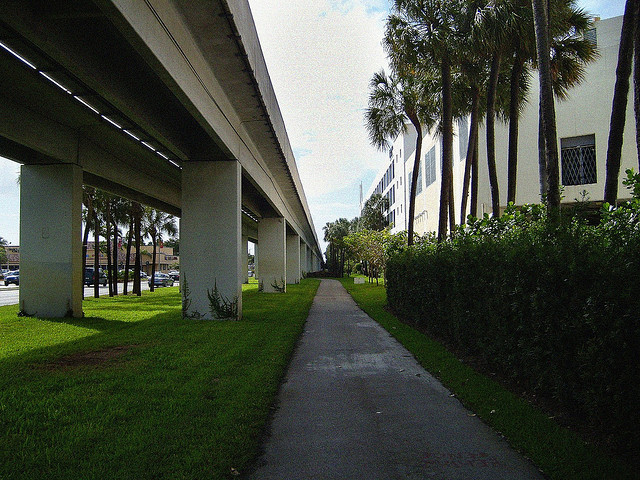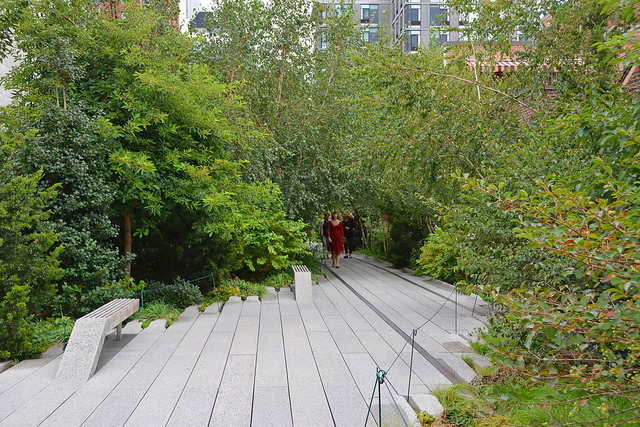
How did Miami’s proposed ‘Underline’ reach its tipping point so quickly?
Meg Daly is founder of Friends of The Underline. Knight Foundation provided seed funding for the project to promote community engagement in Miami. Photo: Metrorail’s MPath.
In 1999, New York’s High Line founders Joshua David and Robert Hammond didn’t know each other. But after bumping into each other at a community meeting discussing the above-ground rail line’s pending demolition, they decided to save it.
Fifteen years later, the High Line founders not only saved the 1.5-mile rail line’s demise, they created something probably beyond their wildest dreams. This “park in the sky,” located on New York’s Lower West Side, has more than 4 million visitors a year and is the city’s second most visited cultural institution. Recognized for its iconic design and magical landscape narrative, the rezoned district has also attracted over $2 billion in adjacent real estate development. In more ways than one, the High Line is the gold standard of linear parks.
A couple of summers ago I was walking under Miami’s MetroRail line along U.S. 1, and I was surprised by how underutilized the land and asphalt trail—the MPath—were. I had visited the High Line and seen the amount of green space that could be squeezed into a 60-foot corridor, so it dawned on me that here was abundant land waiting to be turned into a park. I had no idea that two years later I would be leading the initiative to create The Underline: a 10-mile linear park and urban trail, from the Miami River to Dadeland South under Miami’s MetroRail.
I am an entrepreneur, which means I’m all about getting to the end line. I have found that my business skills, such as market testing and validation, team building, engagement and collaboration, planning, implementation, brand building, and more, are essential in driving the Underline initiative forward.
Under Miami’s Metrorail by Alfonso Surroca on Flickr.
Market Validation: First up, we needed feedback. I talked up The Underline whenever and wherever I could. Since I got a lot of “I love it” responses, I knew we were on to something.
Team Building: The Underline land is owned by Miami-Dade Transit so we had to talk to them. And, since we are building a park space, we needed to get the parks department involved. So, how could I meet these folks?
Luck. I met Maria Nardi, the head of planning for the parks department, at a party and talked up The Underline. She loved it so she set up a meeting with Jack Kardys, the parks department director. He loved it too, so much that within a couple of weeks we were all meeting with the head of transit. We now had the beginning of a team.
New York’s High Line. Photo by Alison Pasciuto on Flickr.
Planning: Anything you build needs a plan, and that planning usually involves money—especially when building a 10-mile linear park. First hurdle, we had no money.
So, we turned to the University of Miami School of Architecture. The dean at the time, Lizz Plater-Zyberk, loved the Underline idea and committed a design studio, pro bono, to the cause.
This is when things got fun. Last spring 10 architecture students embarked on “Rethinking the MPath.” Each student was assigned a mile to design; that’s 10 miles of plans.
The class tackled three critical project components: the trail, widening the path to 20 feet, lighting it and adding basic amenities; the stations, how to include public spaces and services and attract development; and the connected park nodes that make up the linear park.
Collaboration: How do you collaborate on a project that touches on many government agencies, municipal and county approvals and impacts 400,000 people? A design studio.
The first two weeks of the studio were devoted to information sharing. There were deep info dives from the parks, transit and public works departments, the Florida Department of Transportation and more. During the semester we had open reviews and dialogue. By the end of the studio in May, 150 people attended the final review, including Miami-Dade County’s deputy mayor, two municipal mayors and four commissioners.
Marketing: At this time, we had received lots of press. We had launched our website and the signups were rolling in; people were liking our Facebook page and I was learning how to tweet.
At the same time, we tackled the public domain. Over a period of a few months, we got in front of every mayor and commissioner who would see us. (No small task.) We now have formal endorsements from the cities of Miami, Coral Gables, South Miami and Pinecrest, plus a number of biking groups.
We thought we could do even more with outreach. We wanted to strengthen the brand and recently changed the name of the project from the GreenLink to The Underline. As the GreenLink we grew to over 1,200 Facebook friends and our Twitter following has been gaining steam. Our followers have been supportive during our many events and activities and we believed they would come along for the adventure with the new name and logo.
Momentum: What’s next? Since we have broad-based support we are working on funding for the professional planning and design of the 10 miles. So, far, we have funding pledged from the county and the cities of Miami, Coral Gables and South Miami, as well as Knight Foundation, The Miami Foundation and the Health Foundation of South Florida.
Why: I like to say we have gone from an idea to an initiative. That means, we are still an idea but we have lots of traction.
To get traction, your idea has to be sticky; it has to resonate with lots of people. So maybe you’re wondering, “There are a lot of good ideas out there, why did The Underline move so fast?”
To answer that question, please look for my next post “Why The Underline is Sticky.”
Follow The Underline on Facebook and Twitter.
Recent Content
-
Community Impactarticle ·
-
Community Impactarticle ·
-
Community Impactarticle ·




